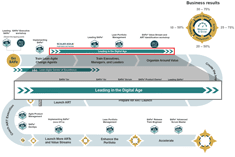
Daring leaders fight for the inclusion of all people, opinions and perspectives because that makes us all better and stronger. That means having the courage to acknowledge our own privilege, and staying open to learning about our biases and blind spots.
— Brene Brown
Leading in the Digital Age
This is article five in the SAFe® Implementation Roadmap series. Click here to view the entire roadmap.
Details
The previous articles in the SAFe Implementation Roadmap series described the first four ‘critical moves:’
- Reaching the Tipping Point
- Train Lean-Agile Change Agents
- Create a Lean-Agile Center of Excellence (LACE)
- Train Executives, Managers, and Leaders
Various SAFe Practice Consultants (SPCs) are now prepared to lead the change alongside leaders trained in the Framework. These leaders understand the need to be actively engaged in the SAFe transformation. This article describes how Lean-Agile leaders enable each step in the implementation roadmap by demonstrating effective change leadership. Previously in the roadmap, we guided leaders to learn the new ways of working by attending Leading SAFe. This experience emphasized that leadership requires action and provided a foundational understanding of the changes needed to adopt SAFe. Once leaders are oriented to the work to be done, the next step they must take is to lead the change.
The Need for Leadership
A recent study [1] at MIT surveyed over 4,000 executives in more than 120 countries. Less than 10% of respondents agreed that their organization’s leaders had the right skill sets to thrive in a digital economy. This study asserts that digital age challenges require leaders to move away from past behaviors and mindsets, strengthen others, and develop new behaviors and competencies critical to success in modern organizations. Negative leader behaviors, legacy cultures, traditional organizational designs, and rigid workforce management that once defined excellence have become less relevant and less valuable. Unfortunately, many leaders do not conduct regular self-assessments and 360 reviews that would uncover opportunities to evolve and improve how they lead.
These patterns often emerge in the context of adopting SAFe. Organizations that failed to focus on developing engaged Lean-Agile leaders to guide their SAFe journey have reported the following challenges:
- The transformation stalled after a few initial wins
- Fixed mindsets proliferated and preserved old ways of working
- New silos emerged with the same territorial behaviors as the previous organization
- Senior leaders did not provide middle management with the professional development and incentive models needed to create permanent change
- The business continued to lack the resilience needed to adapt quickly to changes in the market
- The transformation relied on the heroic efforts of a handful of individuals rather than inspiring a volunteer army to a common purpose
- Enterprise strategy remained disconnected from execution
- A thin veneer of Lean-Agile words and ceremonies masked unchanged processes and cultural norms
Conversely, those organizations that changed the leadership culture as an integral part of changing how they deliver value dominate their respective markets.
Leading the Transformation
Leaders in organizations transitioning to Lean-Agile as their way of working using SAFe must develop new competencies and practices for achieving business agility. In this step of the roadmap, SPCs will be helping leaders develop along the three distinct dimensions of the Lean-Agile Leadership core competency, strengthening the foundation for change. Additionally, these Lean-Agile Leaders will learn by doing, practicing new communication techniques, change leadership, and engagement as they lead the change [2]. SAFe encourages leaders to study the change leadership guidance of Dr. John Kotter, available through his many books and published articles. The steps in the Implementation Roadmap are closely aligned with Dr. Kotter’s change accelerators described below.
Create a Sense of Urgency
Transforming the organization to embrace SAFe as the new way of working requires leaders to help others see the need for this change and the importance of acting immediately. This means clearly communicating why the change is needed and in a way that makes people want to help make the change successful. But leaders must do more than communicate the need for change. They must demonstrate strong advocacy for embracing SAFe in what they do and say. They must also use their relationships and influence to gain buy-in from others in the organization whose support is needed for the change to be successful.
Build a Guiding Coalition
Every SAFe implementation needs a committed group guiding the change – one with the right mix of leadership skills, bias for action, credibility, people skills, and analytical abilities. The LACE serves as a dedicated team within this guiding coalition, so leaders must properly form, fund, and empower this group of change agents. An effective LACE should include people with a variety of perspectives and skills who work as a high-performing team. The LACE members should inspire trust and build buy-in for the change as they train and coach the organization in adopting SAFe roles, practices, and mindsets.
Form a Strategic Vision
One of the most important responsibilities for leaders and the LACE in a SAFe implementation is to communicate a clear and compelling description of how things will be once the new ways of working have been adopted and how that vision aligns with the broader strategic goals of the organization. Transformation OKRs are an effective tool for describing the specific objectives for implementing SAFe. The key results provide the details for how each outcome will be achieved and how those results will be measured. Applying OKRs to the SAFe transformation provides a focus on the expected benefits, generates alignment and transparency, and creates commitment to the journey that is about to begin.
Enlist a Volunteer Army
Successful implementation of SAFe cannot be achieved by a handful of leaders and the LACE alone. It requires what Kotter describes as a ‘volunteer army’ of people in the organization fully embracing and actively contributing to the change. The training outlined in the roadmap is a great start, but knowledge alone is rarely sufficient to create buy-in. It requires addressing both thoughts and emotions of the people who must adapt their ways of working. It also requires more than a one-size-fits-all, top-down communications approach. Change leaders and LACE members must use a variety of communication methods and styles to engage with the large and diverse group of stakeholders who need to be recruited into the volunteer army.
Enable Action by Removing Barriers
Every SAFe transformation will inevitably encounter individual, group, and organizational barriers that can slow or even block the change. Leaders play a vital role in overcoming these barriers by identifying potential problems, discovering root causes, and developing possible solutions. More importantly, leaders empower knowledge workers to do the same. They allow others to challenge the status quo, offer ideas, and work through objections. They champion a continuous focus on the vision and intended business outcomes for the change. Leaders also understand that the best way to overcome barriers is through a relentless dedication to building understanding and buy-in.
Generate Short Term Wins
One of the most powerful ways to overcome objections to change is to create visible, unambiguous success as soon as possible and throughout the transformation. Leaders and the LACE should showcase short-term wins immediately any time the new ways of working produce a faster flow of value, better quality, motivated teams, or happy customers. Achieving key results from the transformation’s OKRs is also a cause for celebration. This creates a pull culture for more teams to be excited about starting their own SAFe journey. Publicly celebrating success also provides an excellent opportunity to recognize and reward those responsible for the wins.
Sustain Acceleration
Leaders and LACE members should take care to avoid declaring victory too soon in the journey to adopting SAFe. Even when everyone has been trained, and all ARTs have been launched, the transformation is far from over. New barriers will emerge. Old habits and mindsets will surface, especially in moments of crisis. Over time, staff turnover will bring new team members who do not have the shared experiences created during the transformation. At this point, it is easy for energy, focus, and even the budget devoted to adopting SAFe to be diverted to ‘the next big thing.’ Leaders can help sustain the change by sharing the successes and business benefits of the implementation with other parts of the enterprise that have not yet embraced SAFe. They can also advocate for implementing Lean Portfolio Management if that has not yet occurred. Leaders can also support a long-lived and well-funded LACE that will provide ongoing training, coaching, and relentless improvement in the organization’s SAFe practices.
Institute Change
Over time, the new ways of working described in SAFe become engrained as simply ‘the way we do things here.’ In other words, Lean-thinking and Agile alter the organization’s culture. The evidence of better business results is unquestionable. A growing number of the largest organizations in the world who have reached this stage in their SAFe journey have shared their success stories on stage at Global SAFe Summits and through published case studies. The final step to permanent change is identifying and adjusting processes, policies, and systems to anchor the change. Leaders can use their positions of responsibility to ensure that Lean-Agile practices are engrained in strategy formulation, budgeting, people practices, metrics, and any other areas required to make the change stick.
Leading by Example
Kotter’s eight change accelerators help leaders know what to do to lead change. How leaders lead will determine how the rest of the organization responds to their efforts.
The first responsibility of leaders is to create an environment that enables others to adapt successfully to new ways of working. This requires leaders to start by setting an example. Through their words and actions, leaders provide their organizations with patterns of expected behaviors. The aggregation of those patterns determines the organization’s culture, whether good or bad. The most helpful technique for driving the cultural change needed to succeed in the digital age by implementing SAFe is for leaders to model the behaviors and mindsets that enable others to follow their example.
The MIT study cited in this article describes the enduring and emerging behaviors needed for leaders to succeed in the digital age. These behaviors are consolidated into the following attributes described in the Lean-Agile Leadership competency article:
- Insatiable learning
- Authenticity
- Emotional competence
- Courage
- Growing others
- Decentralized decision-making
Increased mastery of these attributes will help leaders be even more effective as they lead the implementation of SAFe.
New Resources for Leaders
To help leaders upskill and relentlessly improve the competencies required to lead in the digital age, Scaled Agile recently released a new leader development series called Leading in the Digital Age. The first two modules in the series perfectly align with the dimensions of Lean-Agile Leadership summarized in this article. They include:

Leading by Example – Leading by Example is designed to provide a solid foundation of leader behaviors that will represent the cornerstone for this learning journey. You will have the opportunity to learn about the four most important leader behaviors that help create the environment of trust essential for Lean-Agile to work successfully in your organization. You will practice these behaviors in the live sessions and in the self-paced work you complete before each session. You will also be provided with specific strategies and tactics for the continued development of these behaviors far beyond the conclusion of this module’s formal learning activities.

Accelerating Change Leadership – This module of Leading in the Digital Age is designed to provide a basic understanding of the best practices of change leadership based on Dr. John Kotter’s Eight Accelerators for Successful Change and Four Change Leadership Principles, with a focus on how to determine whether or not you have some critical success factors in place. You will also have the opportunity to gain a more in-depth understanding of how to create messages and communications that build buy-in and urgency for an existing or new change. As a result, you will walk away with strategies and tactics to put in place the basic conditions that will help create success for a new or upcoming change and make adjustments that will enhance the success of an ongoing change.
Moving Forward
With the Lean-Agile Center of Excellence ready to facilitate the following steps, and leadership exemplifying the skills and behaviors required to lead the transformation to SAFe, we continue in the next critical move, Organize Around Value.
This article serves as a launching pad to explore these steps in detail and understand how to apply them to specific implementations.
Learn More
[1] Ready, Douglas, Carol Cohen, David Kiron, and Benjamin Pring, The New Leadership Playbook for the Digital Age, MIT Sloan Management Review, January 2020.
[2] Kotter, John P. Leading Change. Harvard Business Review Press, 2012.
Last update: 3 November 2022